When you think about this for a minute, you realize that you have different types of items. If you’re a retailer, for example, the inventory that you sell may appear in an invoice. If you provide discounts to different sorts of customers, discounts may appear in an invoice as a line item. If you’re in a state that taxes sales, sales tax appears as a line item in an invoice.
You describe different items in different ways. You describe an inventory item that may appear in an invoice differently from the way you describe a sales tax that you’re required to charge.
To add an item to your Item list, follow these steps:
-
Choose the Lists→Item List command.
QuickBooks displays the Item List window.
-
To display the Item menu, click the Item button, which appears in the bottom-left corner of the Item List window.
QuickBooks displays the Item menu.
-
Choose the New command.
This command tells QuickBooks to display the New Item window.
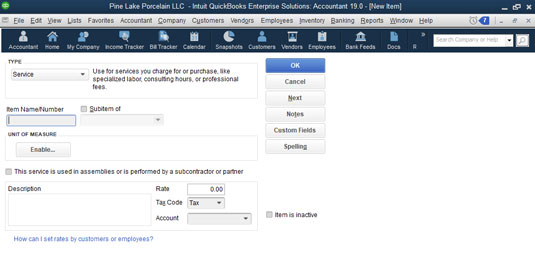 The New Item window.
The New Item window. -
Use the boxes of the New Item window to describe the item that you want to add.
Your first step is to identify the type of item that you want to add. Based on the type of item, QuickBooks supplies other boxes that you use to describe the item.
-
Save the item.
After you use the boxes in the New Item window to describe the item that you want to add, click OK. QuickBooks adds the item that you just described in the Item list.
The step-by-step approach described in the preceding paragraphs is the conventional way to add an item, but you can also add items on the fly. For example, if you’re using the Create Invoices window or the Create Purchase Orders window, you can open the Item drop-down list and select Add New Entry from the list.
When you do this, QuickBooks displays the New Item window. Then you use the New Item window to add the item in the manner discussed here.
How to add a service item to the QuickBooks Item List
You use service items to purchase or bill for items that represent service. If you're a CPA, you probably prepare tax returns for individuals and businesses. When you bill a client for preparing his or her tax return, the line item that appears in the invoice for Tax Return Preparation is a service item.In your business, you probably have service items too. A health-care provider, such as a dentist or doctor, provides treatment or performs procedures. Dentists might fill cavities. Doctors might perform physicals or give vaccinations. These activities represent services.
Even retailers and contractors — businesses that you typically think of as selling tangible physical goods — often sell services. A retailer may gift-wrap a purchase, which is a service. A contractor may provide services such as painting and cleanup.
To add a service item, display the New Item window, and choose Service from the Type drop-down list. In the Item Name/Number box, give the service a brief code or name. If the service is a subitem, select the Subitem Of check box and identify the parent item.
Select the check box titled This Service Is Used in Assemblies or Is Performed by a Subcontractor or Partner if the service is provided by (as the window suggests) a subcontractor, owner, or partner. You indicate which services are performed by subcontractors, owners, and partners because these parties are subject to different tax accounting rules.
Next, use the Description box to describe the service. Your description appears in invoices and purchase orders, so you want to be thoughtful here. Use the Rate box to describe the price or rate per unit of service. Use the Tax Code drop-down list to indicate whether the service is taxable. Finally, use the Account drop-down list to identify which income account should be credited when the item is sold to some customer, client, or patient.
How to add an inventory part to the QuickBooks Item List
Inventory parts are those items in invoices and purchase orders that represent physical goods that you buy, hold, and sell. If you’re a retailer, all that stuff that’s sitting out on the shelves of your store represents inventory. If you’re a manufacturer, the raw materials that you buy and then use to assemble your products represent inventory.To set up an inventory part, display the New Item window, and choose Inventory Part from the Type drop-down list. QuickBooks displays the Inventory Part version of the New Item window.
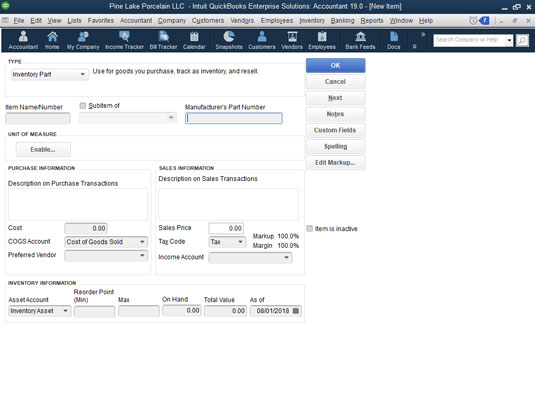 The Inventory Part version of the New Item window.
The Inventory Part version of the New Item window.Use the Item Name/Number box to provide a descriptive but brief code or name for the item. If the item is a subitem of some other parent item, select the Subitem Of check box and then identify the parent item by using the Subitem Of text box.
The Purchase Information and Sales Information boxes let you determine the information that appears in purchase orders and invoices. The Description on Purchase Transactions box in the Purchase Information area, for example, lets you provide the text that QuickBooks displays in purchase orders. You can also guess at the purchase cost by using the Cost text box. Specify the cost of goods sold (COGS) account that should be debited when this item is sold by choosing it from the COGS Account drop-down list, and identify the preferred vendor for purchases of this item by choosing that vendor from the Preferred Vendor drop-down list.
The Sales Information boxes provide the information that QuickBooks needs to correctly include the item in an invoice. The Description on Sales Transactions box provides a space that you can use to supply the description that QuickBooks should use for this item on your invoice. The Sales Price box enables you to provide your price for the item. If you’re subject to sales tax, you see (and should use!) the Tax Code drop-down list to specify whether the item is taxable or nontaxable for sales tax purposes. Finally, the Income Account drop-down list lets you specify which income account should be credited when this item is sold.
If you’re confused about seeing three Account drop-down lists in the Inventory Part version of the New Item window, keep in mind that when you sell an item, you track the income by crediting an income account and the cost of goods sold by debiting the COGS account.
Use the Inventory Information boxes to describe how QuickBooks should handle inventory tracking for the item. Use the Asset Account drop-down list, for example, to specify which account QuickBooks should use to track the dollar investment in this item. Typically, you use the Inventory Asset account, but you can conceivably use some other asset account. Use the Reorder Point boxes to identify the inventory stocking level at which you want QuickBooks to alert you to reorder the item. If you have inventory on hand for this item, enter the quantity that you have on hand and the value that you have on hand in the On Hand and Total Value boxes. You also specify the date as of which your quantity and value information is correct by using the As Of box.You really shouldn’t be entering inventory balances for an inventory item when you set it up in the Item list. You should be entering or changing inventory quantities and values when you purchase the inventory (recorded in the Create Purchase Orders window or the Write Checks window) and when you sell the inventory (typically recorded in the Create Invoices window or the Sales Receipts window). If you enter a quantity other than zero or a total value other than zero in the New Item window, you also need to make a journal entry to record the other half of the transaction. If this “other half” business sounds complicated, just trust me: You shouldn’t be entering quantity or value information in this window. If you do understand this “other half” business that I’m referring to, you should know better than to enter quantity or value information in the New Item window!
You can click the Spelling button to check the spelling of words and phrases that you’ve entered in the New Item window. You can also click the Next button to save the information that you’ve entered for an item and redisplay the New Item window so that you can add another item.
How to add a noninventory part to the QuickBooks Item List
To add a noninventory part — which is a tangible good that you sell but for which you don’t track inventory — display the New Item window, and choose Non-Inventory Part from the Type drop-down list. When QuickBooks displays the Non-Inventory Part version of the New Item window, give the noninventory part a name or code by using the Item Name/Number box. If the new item is a subitem, select the Subitem Of check box and then identify the parent item by using the Subitem Of text box. Use the Description box to provide the description that should go in invoices that bill for this noninventory part. Obviously, you enter the price in the Price box. Use the Tax Code drop-down list to identify whether the item is subject to sales tax. Finally, use the Account drop-down list to identify the income account that should be credited for sales of this noninventory part.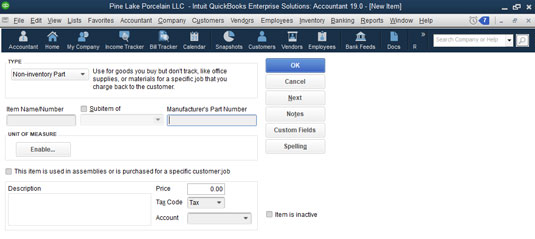 The regular Non-Inventory Part version of the New Item window.
The regular Non-Inventory Part version of the New Item window.Note the check box labeled This Item Is Used in Assemblies or Is Purchased for a Specific Customer:Job. If you select that check box, QuickBooks displays a slightly different version of the Non-Inventory Part window. This version of the window includes Purchase Information and Sales Information areas that work the same way as the Purchase Information and Sales Information areas supplied by the regular Inventory Part version of the New Item window.
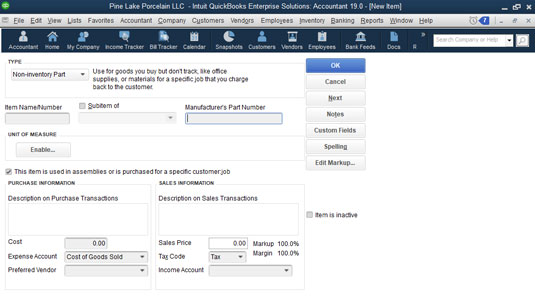 The kooky Non-Inventory Part version of the New Item window.
The kooky Non-Inventory Part version of the New Item window.How to add an other-charge item to the QuickBooks Item List
An other-charge item is an item that you use to purchase or bill for things such as miscellaneous labor or services; materials that you aren’t tracking as inventory; and special charges, such as for delivery or setup or rush jobs.To set up an other-charge item, display the New Item window, and choose Other Charge from the Type drop-down list. When you do, QuickBooks displays the Other Charge version of the New Item window. To finish setting up your other charge item, give the charge a name or code or abbreviation by using the Item Name/Number box. If the other charge item is a subitem, select the Subitem Of check box and then identify the parent item by using the Subitem Of text box. Obviously, you use the Description box to provide a description of the charge. (Remember that this description appears in your invoices.) Use the Amount or % box to identify how the charge gets calculated or billed. Use the Tax Code drop-down list to identify the charge as subject to sales tax — or not subject to sales tax. Use the Account drop-down list to identify the income account that should be credited when you bill for this other charge.
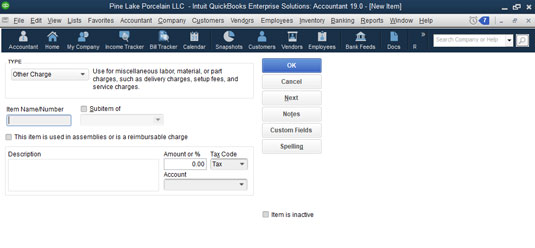 The Other Charge version of the New Item window.
The Other Charge version of the New Item window.If you select the check box titled This Item Is Used in Assemblies or Is a Reimbursable Charge, QuickBooks adds a second set of boxes to the New Item window. One set of boxes, labeled Purchase Information, provides information that goes in purchase orders or is used to record purchases and purchase orders. The other set of boxes, labeled Sales Information, goes in invoices and sales receipts to record the actual sale or billing for the other charge.
If you want to enter another charge that should be calculated as a percentage, you must enter the % symbol in the Amount or % box. To include an other-charge item in invoices that equals 25 percent of the previous item in the invoice, for example, enter 25% in the Amount or % box.
How to add a subtotal item to the QuickBooks Item List
If your purchase order, sales receipt, or invoice includes a subtotal line item, you create a subtotal item in your Item list. To do this, display the New Item window, and choose Subtotal from the drop-down list. Next, give the subtotal item a name or abbreviation, and use the Description box to describe the subtotal. Finally, check the column or columns you want QuickBooks to subtotal. (Usually, you want only the amount column to be totaled, but you can also have the quantity, price, and cost columns totaled too.) The figure shows the Subtotal version of the New Item window.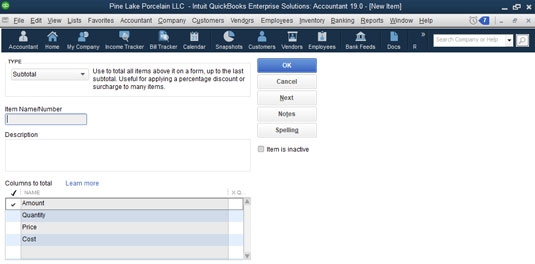 The Subtotal version of the New Item window.
The Subtotal version of the New Item window.If you’re using other charge items that are calculated as a percentage or discount items that are calculated as a percentage, you almost certainly need a subtotal item. Another charge that is calculated as a percentage typically would be calculated as a percentage of a subtotal item. Similarly, a discount item that’s calculated as a percentage is calculated as a percentage of a subtotal item.
How to add a group item to the QuickBooks Item List
A group item lets you more easily invoice customers when, from the customer’s perspective, he or she is buying a single item, but from your perspective, you’re actually selling several items. This definition sounds curious at first, but let me give you a quick example. Suppose that you’re a florist who does booming business on Valentine’s Day. Your best-selling items may be red roses and pretty crystal vases. But you probably don’t sell individual roses and individual vases. You actually sell a dozen roses with a single vase. Although you want to individually track purchases of dozens of red roses and individual crystal vases in your purchase orders, in your invoices to customers, you want to bill for “a dozen red roses in a crystal vase.”If that example doesn’t make sense, imagine a more complex floral arrangement including a dozen red roses, a crystal vase, baby’s breath, flower preservative, tissue-paper wrapping, ribbon, a box, and so forth. In this case, do you really want an invoice that shows perhaps 20 items? Or do you want an invoice that shows a single item: a dozen red roses in a crystal vase? This is why you create group items. A group item lets you create a single item that you use in invoices, but this group item actually combines a bunch of individual items that you’re probably using in your purchase orders.
To create a group item, display the New Item window, and choose Group from the Type drop-down list. When QuickBooks displays the group version of the New Item window, use the Group Name/Number box to give the group item a name or code. Use the Description box to give the group item an appropriate description. Use the Item, Description, and Qty columns at the bottom of the window to identify the individual items and item quantities that combine to make a group.
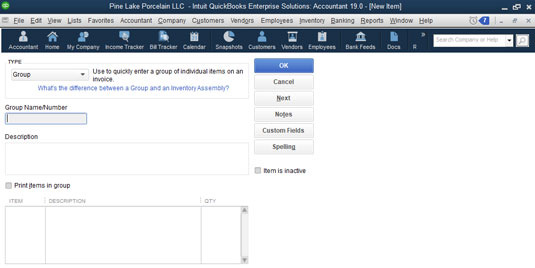 The Group version of the New Item window.
The Group version of the New Item window.How to add a discount item to the QuickBooks Item List
A discount item subtracts a fixed amount or a percentage from a subtotal. To set up a discount item, display the New Item window, and choose the Discount entry from the Type drop-down list. When you do, QuickBooks displays the Discount version of the New Item window.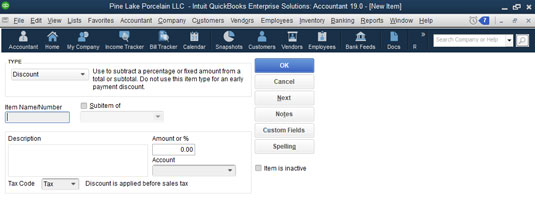 The Discount version of the New Item window.
The Discount version of the New Item window.To set up your discount item, enter a name or abbreviation for the discount in the Item Name/Number box. If the discount item is a subitem, select the Subitem Of check box and then identify the parent item by using the Subitem Of text box. Typically, you describe the discount by using the Description box. Enter the amount of the discount in the Amount or % box as a dollar amount or as a percentage. (If you do enter the discount as a percentage, be sure to include the percentage symbol.) Use the Account drop-down list to specify which account gets debited for the discount. Finally, use the Tax Code drop-down list to indicate whether the discount is applied before sales tax. (In other words, indicate whether the discount is subject to sales tax.)
If you set up a discount item that calculates the discount as a percentage, you probably also need a subtotal item. Then, in your invoices, follow the subtotal item with the discount item. In this manner, you can easily calculate the discount percentage by looking at the subtotal amount.
How to add a payment item to the QuickBooks Item List
If you sometimes accept payments at or before the point you invoice a customer, you can create a payment item and then add the payment item to the bottom of the invoice. If you do this, the invoice, the payment amount, and the net amount due all appear in the same document. That’s pretty cool.To set up a payment item, display the New Item window, and choose Payment from the drop-down list. QuickBooks displays the Payment version of the New Item window. Use the Item Name/Number box to give the payment item a code or name such as “payment.” Use the Description box to provide a nice description of the payment. (No kidding, you may want to include the phrase Thank you as part of the payment description, such as Payment … thank you!) Use the Payment Method drop-down list to identify the method of payment: American Express, check, cash, Discover, MasterCard, or Visa, as appropriate. Finally, use the radio buttons — Group with Other Undeposited Funds and Deposit To — to identify what happens to the money received as part of the payment. If you indicate that the money is deposited, you also choose the correct bank account from the Deposit To drop-down list.
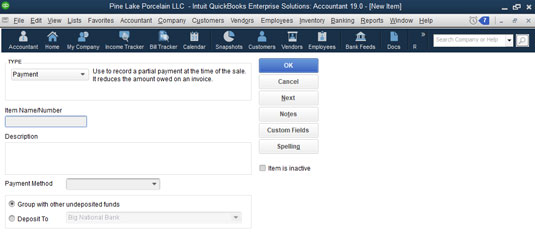 The Payment version of the New Item window.
The Payment version of the New Item window.How to add a sales tax item to the QuickBooks Item List
If you sell items that are subject to sales tax, you also include line items in your invoices that charge for and track these sales taxes. To do this, you create sales tax items. To create a sales tax item, display the New Item window, and choose Sales Tax Item from the Type drop-down list. When you do, QuickBooks displays the Sales Tax Item version of the New Item window. Use the Sales Tax Name box to identify or provide an abbreviation for the sales tax. Use the Description box to give the sales tax a description. Finally, use the Tax Rate (%) box to identify the sales tax rate and the Tax Agency (Vendor That You Collect For) drop-down list to identify the tax agency that you’ll pay.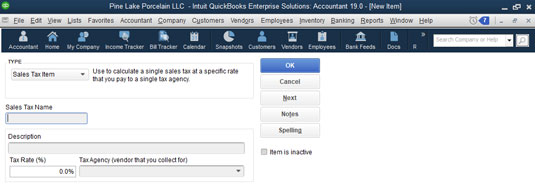 The Sales Tax Item version of the New Item window.
The Sales Tax Item version of the New Item window.
